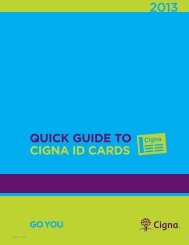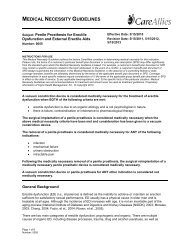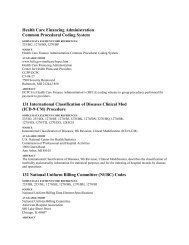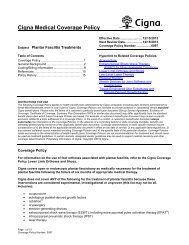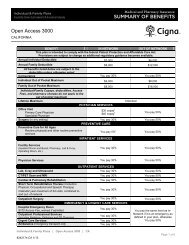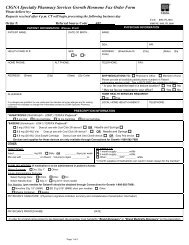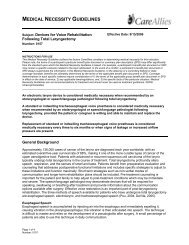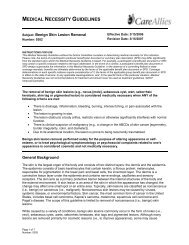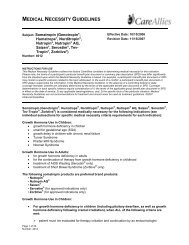Electrical Stimulators - Cigna
Electrical Stimulators - Cigna
Electrical Stimulators - Cigna
You also want an ePaper? Increase the reach of your titles
YUMPU automatically turns print PDFs into web optimized ePapers that Google loves.
ongoing assessment and management and is not expected to remit in a foreseeable interval of time. The pain<br />
may be excruciating, constant and interfere with daily activities. Pain that is chronic, persistent and not relieved<br />
by conventional medical or surgical management is considered intractable. There may have been an initial<br />
condition or mishap (e.g., infection, injury, sprained back) that became chronic or an ongoing condition (e.g.,<br />
arthritis, cancer). Other people suffer chronic pain in the absence of any past injury or evidence of body damage<br />
and the etiology is unknown. Common chronic pain complaints include joint pain, low back pain, cancer pain,<br />
arthritis pain, neurogenic pain (i.e., pain resulting from damage to the peripheral nerves or to the central nervous<br />
system itself) and/or psychogenic pain (pain not due to past disease or injury or any visible sign of damage<br />
inside or outside the nervous system). The treatment of chronic pain is typically multidimensional and may<br />
include pharmacotherapy, exercise, relaxation, acupuncture and/or behavior modification. Depending on the<br />
condition, transcutaneous electrical stimulation (TENS) or surgical intervention may be appropriate (American<br />
Association for Chronic Pain, 2011; National Institute of Neurological Disorders and Stroke, 2011; Singh, et al.,<br />
2011).<br />
A TENS device consists of an electronic stimulus generator that transmits pulses of various configurations<br />
through electrodes on the skin to stimulate the peripheral nerves for the purpose of pain management.<br />
Conventional TENS or high frequency TENS delivers 40–150 hertz (Hz) compared to acupuncture-like TENS<br />
that delivers a low frequency at 1–10 Hz. Pulsed TENS uses low-intensity firing in high-frequency bursts at 100<br />
HZ. TENS has been used for a number of applications, including acute and chronic pain, postoperative pain,<br />
obstetrical pain, and pain associated with medical procedures.<br />
U.S. Food and Drug Administration (FDA): TENS are approved by the FDA 510(k) process as a Class II<br />
device for the relief and management of chronic intractable pain. Examples of these devices include the Empi<br />
Active Transcutaneous Nerve Stimulator (Empi, Inc., Clear Lake, SD), the StimPad TENS System (AEMED,<br />
Inc. West Palm Beach, FLA), Calmare ® Pain Therapy Treatment (Competitive Technology, North Attleboro,<br />
MA).<br />
Literature Review - Acute Postoperative Pain and Chronic Pain: The evidence in the peer-reviewed<br />
literature supports TENS for the treatment of pain in the acute post-operative period (i.e., within 30 days of<br />
surgery) and as a secondary treatment option for patients with chronic pain when conventional therapies (e.g.,<br />
nonsteroidal anti-inflammatory drugs, physical therapy) have failed. TENS is a well-established treatment<br />
modality for these indications. Systematic reviews, meta-analysis and randomized controlled trials reported a<br />
reduction in pain and analgesic use in the treatment of acute post-operative pain and chronic pain (e.g., back<br />
pain, osteoarthritis of the knees) following TENS (Freynet and Falcoz, 2010; Jin, et al., 2010; Pieber, et al.,<br />
2010; Emmiler, et al., 2008; Cipriano, et al., 2008; Bjordal, et al., 2007; Solak, et al., 2007; Bjordal, et al., 2003).<br />
Literature Review - Other Indications: The evidence in the published peer-reviewed scientific literature has<br />
not established the effectiveness of TENS for the treatment of any other indications including, but not limited to:<br />
acute pain, acute and chronic headaches; abdominal pain, asthma, chemotherapy-induced pain, chronic leg<br />
ulcers, colonoscopy, drug withdrawal (e.g., opiate addiction), dysmenorrhea, fracture healing, hypertension,<br />
mandibular disorders (e.g., neuromuscular orthodontics; temporomandibular joint [TMJ]), motion sickness,<br />
nausea and vomiting of pregnancy, overactive bladder, pain associated with childbirth (i.e., labor), pelvic pain,<br />
post-traumatic acute pain, rotator cuff tendinitis, stroke rehabilitation, suspected placental insufficiency, tinnitus,<br />
urinary incontinence, vestibulodynia, and unstable angina. Overall, systematic reviews, randomized controlled<br />
trials and case series have reported that there was no improvement with TENS for these indications or that<br />
conclusions could not be made due to the poor methodology of the studies. Study limitations included small<br />
heterogeneous patient populations with short-term follow-ups, data insufficient or conflicting data, and the<br />
application of TENS varied (e.g., physician applied vs. patient applied, location of electrodes). Evidence<br />
supporting TENS for these indications is lacking nor is TENS an established treatment modality. The clinical<br />
utility of TENS has not been established for all other indications.<br />
Acute Pain: Walsh et al. (2009) assessed the analgesic effectiveness of TENS in acute pain for adults (n=919)<br />
in a systematic review of 12 randomized controlled trials. The types of acute pain included procedural pain (e.g.<br />
cervical laser treatment, venipuncture, screening flexible sigmoidoscopy) and nonprocedural pain (e.g.<br />
postpartum uterine contractions, rib fractures). The authors were unable to make any definitive conclusions due<br />
to the insufficient extractable data.<br />
Page 5 of 41



